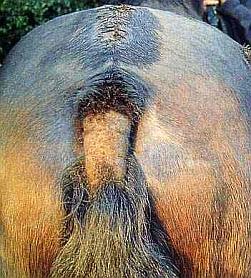| Home Medical Index | First Posted Feb 9, 2010 Jan 21, 2020 | |
Tail Rubbing (Horse)by Debora Johnson Image - Example of sweet itch sores. Also known as Queensland Itch, Summer Itch or more technically, Culicoides Hypersensitivity. Have you ever seen your horse back up to the barn door or a fence and rub his tail? Does your horse do this all the time or just in certain times of the year? Have you ever wondered if there is any significance to this? For that matter, have you seen your horse rubbing his neck, face, belly, legs, and other parts of his body? Well, there very well may be several reasons for this behavior. Many may be the same problems that are inherent with tail rubbing. Let's have a look. Possible Reasons
By using the process of elimination you can probably determine the cause of this problem. Of course, always discuss the problem with your vet. The treatment of tail rubbing is determined by the cause. It can be as simple as a sheath cleaning, a change in feed, steroid use topically or systemically, topical ointments, more turn out, the use of a fly sheet, a change in the worming program, etc. I would also like to mention that tail rubbing occurs in all regions and climates of the United States. It seems that the problem is seen most often in warm and humid areas. Warm, humid climates have more insects. Hypersensitivity to insects is often the problem. |